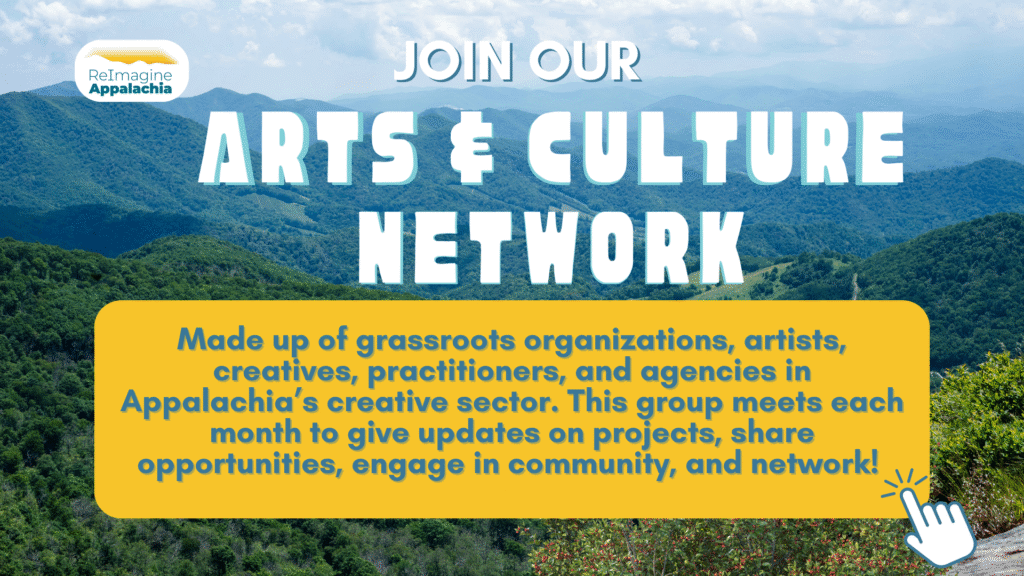August 7, 2025

For Indigenous Peoples’ Day this year, ReImagine Appalachia would like to honor some impactful advocacy work being done by Indigenous folks and allies throughout the region, along with the tribal communities that first called these hills home. We’d like to begin, then, with the Appalachian Regional Commission’s listing of federally and state-recognized tribal communities to acknowledge these groups’ ancestral claims and contemporary sovereignty before spotlighting the Appalachian Rekindling Project’s work in eastern Kentucky.
Tribal Communities in Appalachia
Alabama
- Cherokee Tribe of Northeast Alabama
- Neighbor ARC Counties: Marshall
- Echota Cherokee Tribe of Alabama
- Neighbor ARC Counties: Cullman, Lawrence, Madison
- Piqua Shawnee Tribe of Alabama
- Neighbor ARC Counties: Jefferson
- United Cherokee Ani-Yun-Wiya Nation
- Neighbor ARC Counties: Marshall
Georgia
- Georgia Tribe of Eastern Cherokee
- Neighbor ARC Counties: Lumpkin
Mississippi
- Mississippi Band of Choctaw Indians
- Reservations: Choctaw
- Neighbor ARC Counties: Kemper, Noxubee, Winston
New York
- Seneca Nation of Indians of New York
- Reservations: Allegany, Cattaraugus, Oil Springs
- Neighbor ARC Counties: Allegany, Cattaraugus, Chautauqua
North Carolina
- Eastern Band of Cherokee Indians of North Carolina
- Reservations: Eastern Cherokee
- Neighbor ARC Counties: Cherokee, Graham, Haywood, Jackson, Swain
Our previous blog on indigenous cultures in Appalachia provided an overview of some of the work to amplify Indigenous voices.
Indigenous leaders continue to shape the present and future of Appalachia. One powerful example includes the Appalachian Rekindling Project.
Rekindling the land. Bringing the bison home
The Appalachian Rekindling Project (ARP) is a “region-wide initiative that began to establish and sustain an intertribal Indigenous center where Native people can physically return and gather in central Appalachia as well as to care for and protect land collectively.” The center is in the design stage and is slated to be constructed on over 15 acres in Appalachian Virginia that were gifted to ARP and will be “a free space to be reserved, shared, and engaged with by Indigenous communities and individuals.” The center will be a start to healing the rifts in the community that these groups face.
Land restoration
Though the intertribal Indigenous center is a large focus of ARP’s agenda, their second bucket of work is focused on land restoration. Specifically, ARP uses the practice of rematriation, which is an “Indigenous women-led practice of restoring a people to their rightful place in sacred relationship with their ancestral land.” A recent step in this land restoration was the group’s acquisition of 63 acres of land in Letcher County, KY. These acres in the East Kentucky hills were previously impacted by strip mining. A highly controversial federal prison was proposed for the same land, but with the help of national and community partners, ARP was able to purchase this plot.
The return of the bison
ARP was able to purchase the land and plans to rewild the site, specifically with the American bison. As the activists state on their website, “What was nearly a site of captivity will now be a place of kinship and care,” as their work continues to raise funds to fence the property, allowing the possibility of the return of a native species that were and still are integral to Native cultures. This rewilding goes past reintroducing bison to the area, though, as the group is looking to heal the land at large. The return of the bison is “a living act of healing, memory, and renewal” for the Appalachian Rekindling Project and the Native groups they serve across the region.
This is just one of many examples of the ongoing leadership, impact, and presence of indigenous folks in Appalachia. Others include Venus Evans’ work as the commissioner-at-large of the Kentucky Native American Heritage Commission, the Urban Native Collective’s Urban Garden Project in Cincinnati, and many more. Let us know what other indigenous projects and groups we should lift up and share, as we continue to work on honoring those who first called this land home.
ReImagine Appalachia has covered the enormous issue of former mine sites in our region; researchers estimate that up to a million acres of partially or totally unreclaimed mines remain in Central Appalachia. These sites stymy economic development, pose public health hazards, and increase flood risks. Projects like the Appalachia Rekindling Project offer a powerful model for a path forward for communities dealing with the burden of former mine sites.
Learn more about Bison Belong Here at this link
Donate to the project here

